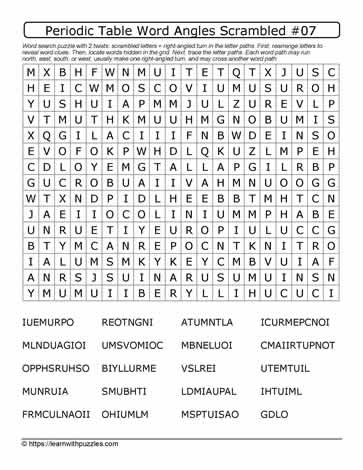Periodic Table Scrambled #07( |
Are you looking for educator resources for academic chemistry? Here is a table of elements wordangle puzzle with a list of 20 scrambled word clues. Many/most letter paths include one right hand turn!
Suggested problem solving strategies (not in any order):
-rearrange the scrambled letters to reveal the hidden words
-record the correct spelling to speed up the process of tracing the letter paths after locating the circled letters
-use prior knowledge about wordangle puzzles: most letter paths cross; word paths travel forwards, backwards, horizontally, vertically, but not diagonally;
-trace word paths
-track progress by checking off the words, or crossing them off
-work with a peer, or group of peers, to solve the puzzle
-do a review of the updated list of words prior to solving the puzzle
Lesson plan activities can include:
1. have students CREATE their own word search puzzles using blank word search grids located here: blank word searches
2. IDENTIFY which elements in the list are: toxic/non-toxic, stable/unstable (remember about the isotopes), is the element a natural element/laboratory discovered? ancient/modern?
3. ORGANIZE the list of elements by a) stability of isotopes, b) toxicity levels (least to most), c) atomic number/weight/mass, d) period, e) group, f) ancient/modern
4. use list of words as research prompts (e.g. details about elements, and related isotopes, discovery, stable vs unstable elements, which elements can be combined to create new compounds?)
5. combine the elements from the list, where possible, to create new compounds (e.g. Hydrogen + Oxygen = H20)
Benefits of using puzzles to complement programming:
1. supports brain health
2. improves memory
3. supports visual acuity
4. activates problem solving strategies and critical thinking skills

